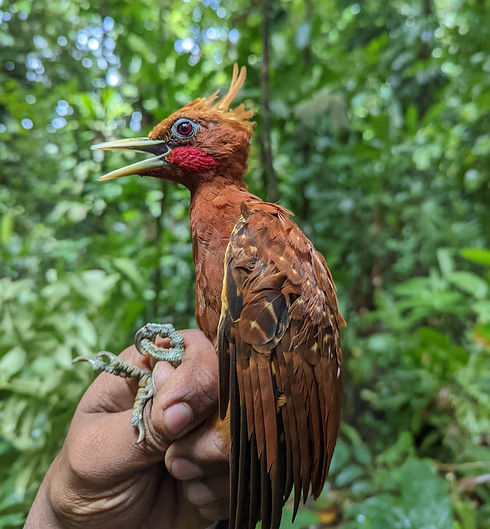

Bird Banding
Research Program
The Bird Banding Research Program at the Trinidad and Tobago Bird Observatory and Research Centre (TTBO) is a cornerstone of our scientific and conservation efforts. This program is designed to monitor bird populations, track migration patterns, and gather critical data on avian life cycles, health, and habitat use. Bird banding involves safely capturing birds, placing a uniquely coded band around their leg, collecting a series of data and releasing them back into the wild. This process allows researchers to track individual birds over time, offering invaluable insights into bird movements, longevity, survival rates, and population trends.
Why we band birds
Through our bird banding efforts, TTBO contributes to a global network of research that is vital for understanding avian ecology and guiding conservation strategies. The data we collect plays a pivotal role in:
-
Tracking Bird Movements: By monitoring where banded birds are re-sighted or recaptured, we can identify migration routes, stopover sites, and wintering areas, which are crucial for conservation planning.
-
Demographic Studies: The information gathered from banded birds helps estimate key demographic parameters such as age structure, survival rates, and reproductive success, providing a deeper understanding of bird population dynamics.
-
Conservation Management: Our research informs conservation efforts by identifying species at risk, important habitats that need protection, and the effects of environmental changes on bird populations.
-
Ecological Research: The ability to track individual birds is essential for many ecological studies, such as those examining the impacts of climate change, habitat alteration, or food availability on bird behavior and survival.
-
Public Education: Bird banding also serves as an engaging educational tool, allowing us to involve the community and visitors in the science of bird conservation, fostering a greater appreciation for the avian species of Trinidad and Tobago.
Aging Birds Using the WRP Method
A key component of our Bird Banding Research Program is the use of advanced aging techniques, including the Wolfe-Ryder-Pyle (WRP) age-classification system. This system, first introduced by Wolfe et al. (2010) and refined by Johnson et al. (2011) and Pyle et al. (2015), revolutionized bird aging by moving away from traditional calendar-based systems. Instead, the WRP method relies on the bird’s molt and plumage cycles, allowing researchers to classify the age of birds with remarkable precision.
Through our Bird Banding Research Program, TTBO continues to advance ornithological knowledge, contribute to regional and international conservation efforts, and foster a community of bird conservationists and researchers. Our research objectives make this program essential to the protection and understanding of Trinidad and Tobago's avian diversity.
